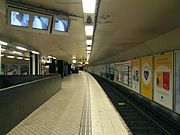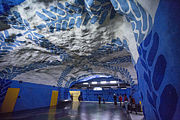
The Stockholm Metro is a rapid transit system in Stockholm, Sweden. The first line opened in 1950 as the first metro line in the Nordic countries, and today the system has 100 stations in use, of which 47 are underground and 53 above ground. There are three coloured lines, as shown on the metro maps, which form seven numbered routes with different termini. Routes numbered 17, 18 and 19, 13 and 14 and 10 and 11 all go through the centre of the city, resulting in a very centralized system. All three lines and seven routes interchange at T-Centralen station. Apart from this, there are three other interchange between lines, at Fridhemsplan, Slussen and Gamla stan stations.
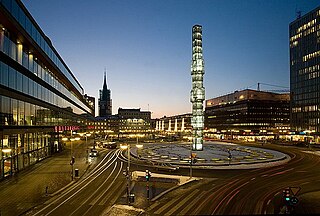
Sergels torg is a major public square in Stockholm, Sweden, constructed in the 1960s and named after 18th-century sculptor Johan Tobias Sergel, whose workshop was once located north of the square.

Djurgårdslinjen is a heritage tram line with the route number 7N, running between Norrmalmstorg and Waldemarsudde in Stockholm, Sweden.
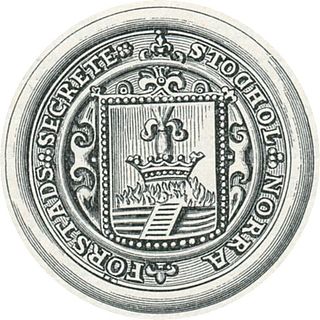
Norrmalm is a city district in Stockholm, Sweden.

Västra skogen is a station on the Blue Line of the Stockholm metro, in Huvudsta, Solna Municipality. The station was opened on 31 August 1975 as part the first stretch of the Blue Line between T-Centralen and Hjulsta. The trains were running via Hallonbergen and Rinkeby. On 18 August 1985 the extension to Rinkeby was opened, and the stretch between Hallonbergen and Rinkeby was closed for passenger traffic. It features one of the longest escalators in western Europe, 66 meters and with a vertical rise of 33 meters. This part of Huvudsta was earlier called Ingentingskogen after a small farm called Ingenting; the name Ingenting (Nothing) was suggested as a name for the new station, but rejected.

Sveavägen is a major street in Stockholm, Sweden.
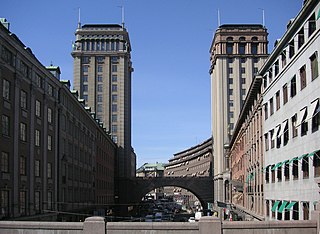
Kungsgatan is a street address in central Stockholm, Sweden.

Gamla stan is a station on the Green and Red lines of the Stockholm metro. It is located on the western side of the Gamla stan district of central Stockholm, and is at ground level, although partly under the Centralbron bridge that carries road and mainline rail across the waterways that define the centre of the city. The same waterways are responsible for the ground level location of the station, unusual for a city centre metro station, as the lines cross between the islands of Stadsholmen and Södermalm by a bridge immediately south of the station.

Östermalmstorg metro station is station on the red line of the Stockholm metro, located in the district of Östermalm. The station was opened on 16 May 1965 as the 59th station in the Stockholm system as the north terminus of the extension from T-Centralen. On 2 September 1967, the line was extended northeast to Ropsten. On 30 September 1973, another extension, north to Tekniska högskolan, was opened. The platform is approximately 38 metres (125 ft) below the surface. It is located in the city center, making it one of the most-used stations in the system, with approximately 38,550 people travelling from the station on an average workday.

Kungsträdgården is a station of the Stockholm metro, located in the district of Norrmalm. It is the end station of line 10 and line 11 and was opened on 30 October 1977, as the 91st station and part of the one-station extension from T-Centralen. The platform is located approximately 34 meters underground. The station features relics rescued from the many buildings pulled down during the redevelopment of central Stockholm during the 1950s and 1960s throughout the station.

Stadshagen metro station is a station on the blue line of the Stockholm metro, located in the district of Stadshagen. The station was inaugurated on 31 August 1975 as part the first stretch of the Blue Line between T-Centralen and Hjulsta. The trains were running via Hallonbergen and Rinkeby. The distance to Kungsträdgården is 3 km (1.9 mi).

Hötorget, formerly known as Kungsgatan, is an underground station on the Green line of the Stockholm metro. It is situated near to the Hötorget square in the borough of Norrmalm in central Stockholm, and lies below Sveavägen between its junctions with Oxtorgsgatan and Apelbergsgatan. The station has three entrances, one at each end and one in the middle from Kungsgatan. The central entrance includes an underground square with several shops and stores. The distance to Slussen is 1.5 km (0.93 mi).

Spårväg City is a tram line in central Stockholm, inaugurated in 2010. It is the first tram line in regular traffic in central Stockholm since 1967. The service is run by AB Stockholms Spårvägar for Storstockholms Lokaltrafik (SL), using the name "Route 7".

Stockholm City Station is a railway station in central Stockholm, Sweden. Opened on 10 July 2017, the station is located on the Stockholm City Line and is located directly below T-Centralen and interchange with Stockholm Central Station. The station serves all Stockholm Commuter Rail trains. It is the busiest railway station in Sweden.

Klara air raid shelter, also known as the Klara bunker, is one of Stockholm's major civil air raid shelters, with an area of 6,650 m2 (71,600 sq ft). The shelter is designed for civilians and members of government, and is located in central Stockholm. The shelter was built during the Cold War, in the 1960s, as central Stockholm was being reformed during the "Redevelopment of Norrmalm". Klara shelter is named after the nearby Klara Church.

The following outline is provided as an overview of and topical guide to Stockholm:

The Red line, is one of the three Stockholm Metro lines. It has a total of 36 stations, of which four are cut and cover, 16 are tunneled, and 15 are on the surface. The line is a total of 41.238 kilometres (25.624 mi) long. It consists of four branches with terminals in Fruängen and Norsborg in the southwest and Mörby center and Ropsten in the northeast.

Åhléns City is a department store in the Norrmalm district in central Stockholm, Sweden. The building is located at Klarabergsgatan 50 and takes up the entirety of the Gripen block. Åhléns City is the largest singular store of the Åhléns chain and amounts to almost 20% of the chain's total revenue. The building was designed by the architectural bureau Backström & Reinius Arkitekter AB, was opened on 9 September 1964 and was awarded the Kasper Salin Prize in 1966. The building is noted by the Stockholm City Museum for "having an obviously high cultural historical value".

The Green Line is the oldest of the three Stockholm Metro lines. The 41.256-kilometre (25.635 mi) long line comprises a single double-tracked line north of the city centre, splitting into three branches south of the city centre. The first section of the line opened as a metro in 1950, making it the first and oldest metro line in the Nordic countries, although some parts of the line date back to the 1930s and were originally used by the Stockholm tramway.

Klarabergsgatan is a main street in the district of Norrmalm in central Stockholm, Sweden. The street runs from Sergels Torg in the east to Klarabergsviadukten in the west, with a length of 350 metres and a width of 36 metres. Most of the houses along the street were built during the redevelopment of Norrmalm. From 2016 to 2018 the street was renovated into a pedestrian zone, with a car lane for public transport and taxis. In 2018 Spårväg City was extended to T-Centralen.











